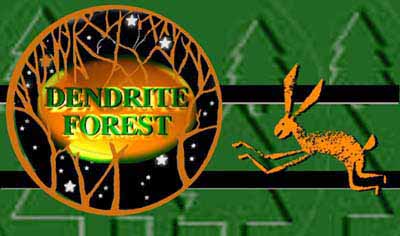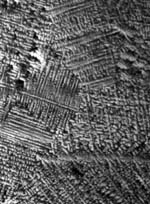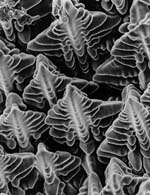
 Webster
Definition for dendrite
Webster
Definition for dendrite - den.drite also den.drit.i.cal \'den-.dri-t\ \den-'drit-ik\ \-i-k*l\ \-i-k(*-)le-\
n 1: a branching figure resembling a tree produced on or in a mineral by a
foreign mineral; also : the mineral so marked 2: a crystallized arborescent
form 3: any of the usu. branching protoplasmic processes that conduct impulses
toward the body of a nerve cell - den.drit.i.c aj
 dendrite
(dčn´drět´) noun
dendrite
(dčn´drět´) noun - 1. a. A mineral crystallizing in another mineral in the form of a
branching or treelike mark. b. A rock or mineral bearing such a mark or marks.
- 2. A branched protoplasmic extension of a nerve cell that conducts
impulses from adjacent cells inward toward the cell body. A single nerve may
possess many dendrites. In this sense, also called dendron.
- The American HeritageŽ Dictionary of the English Language, Third Edition
copyright © 1992 by Houghton Mifflin Company
 Dendroid.
(Gk.)
Dendroid.
(Gk.) - Gk. devdpo.v, a tree; -eldhs, like, from eidos,
form, shape.
- A Concise Etymological Dictionary of the English Language, Skeat,
Capricorn Books, 1963 (My embarrassing misspelling corrected by Professor Nick Humez)
 Architecture, 15 B.C.
(This has nothing to do with Dendritics)
Architecture, 15 B.C.
(This has nothing to do with Dendritics) - The Temple of Dendur in Lower Nubia is erected by the
emperor Augustus on the bank of the Nile.
- The People's Chronology is licensed from Henry Holt and Company, Inc.
Copyright © 1994 by James Trager. All rights reserved.
 Dendrite
International (This also has nothing to do with Dendritics)
Dendrite
International (This also has nothing to do with Dendritics)
 Dendrites
in Graph Theory (This also has nothing to do with Dendritics)
Dendrites
in Graph Theory (This also has nothing to do with Dendritics)



 What Are Dendrites?
What Are Dendrites?

A vast amount of the products and devices that we use
everyday, everything from aluminum foil and soda cans, to cars, jet engines and
computers, are made from metals and alloys. Early in the creation of all these
products the metals are in a liquid, or molten state, that freezes to form a
solid, just like water freezes to form ice. Now, if you were to look at some
just frozen, or freshly solidified metallic alloy with a strong magnifying glass
you would see that its structure is not uniform, but is made up of tiny
individual crystalline grains. Moreover, If you were able to look even more
carefully at the individual grains through a powerful microscope, you would see
that each grain is made up from what looks like a bunch of tiny metallic
snowflakes crowding and growing into each other. Scientists and engineers call
these tiny metallic snowflakes dendrites. The picture to the right shows what a
surface cut through a "forest" of dendrites in a metal would look like through a
microscope.

The term dendrite comes from the Greek word
"dendron", which means a tree. This description is appropriate because we often
describe the form and structure of a metallic dendrite as that of a tree (see
figure to left), with a main branch or trunk, from which grow side branches,
from which grow smaller side branches, and so on, until all the main branches
and the side branches grow into each other and there is no room
 for any more branches to grow. The figure to the right shows a few dendrites
growing out of the surface of a metal. In fact, almost all freshly crystallized
alloys are composed of many thousands, or even millions of dendritic
crystals all stuck together. What's most important is that the shape, size, and
speed of growth of these dendrites are all factors that profoundly influence the
final properties of cast and welded metals.
For example, the dendrites affect how hard or soft a material
is, how stretchable or springy it behaves, and how much you can bend or stretch
it before it breaks. The dendrites also affect both how long and under what
environmental conditions you can use an alloy before it wears out or rusts. The
dendrites affect whether the material is a good or a poor conductor of
electricity. The dendrites even affect how easily you can weld one piece of
metal to another, and what's the best way to do the welding. In short, the
dendritic pattern formed during solidification profoundly influences a
material's mechanical, electrical, and chemical properties.
for any more branches to grow. The figure to the right shows a few dendrites
growing out of the surface of a metal. In fact, almost all freshly crystallized
alloys are composed of many thousands, or even millions of dendritic
crystals all stuck together. What's most important is that the shape, size, and
speed of growth of these dendrites are all factors that profoundly influence the
final properties of cast and welded metals.
For example, the dendrites affect how hard or soft a material
is, how stretchable or springy it behaves, and how much you can bend or stretch
it before it breaks. The dendrites also affect both how long and under what
environmental conditions you can use an alloy before it wears out or rusts. The
dendrites affect whether the material is a good or a poor conductor of
electricity. The dendrites even affect how easily you can weld one piece of
metal to another, and what's the best way to do the welding. In short, the
dendritic pattern formed during solidification profoundly influences a
material's mechanical, electrical, and chemical properties.

 The
Isothermal Dendritic
Growth Experiment
... in space!
The
Isothermal Dendritic
Growth Experiment
... in space!
|
 |
Pivalic acid
dendrite
crystal
grown during Shuttle Flight STS-87
(late 1997) |

Images and webpage designs © 2001-2025
your webmaster, jb and
Dendritics Inc. [-]
![]()
 Webster
Definition for dendrite
Webster
Definition for dendrite  dendrite
(dčn´drět´) noun
dendrite
(dčn´drět´) noun  Dendroid.
(Gk.)
Dendroid.
(Gk.)  Architecture, 15 B.C.
(This has nothing to do with Dendritics)
Architecture, 15 B.C.
(This has nothing to do with Dendritics)  Dendrite
International (This also has nothing to do with Dendritics)
Dendrite
International (This also has nothing to do with Dendritics)  Dendrites
in Graph Theory (This also has nothing to do with Dendritics)
Dendrites
in Graph Theory (This also has nothing to do with Dendritics) ![]()
 What Are Dendrites?
What Are Dendrites?

 for any more branches to grow. The figure to the right shows a few dendrites
growing out of the surface of a metal. In fact, almost all freshly crystallized
alloys are composed of many thousands, or even millions of dendritic
crystals all stuck together. What's most important is that the shape, size, and
speed of growth of these dendrites are all factors that profoundly influence the
final properties of cast and welded metals.
for any more branches to grow. The figure to the right shows a few dendrites
growing out of the surface of a metal. In fact, almost all freshly crystallized
alloys are composed of many thousands, or even millions of dendritic
crystals all stuck together. What's most important is that the shape, size, and
speed of growth of these dendrites are all factors that profoundly influence the
final properties of cast and welded metals. ![]()
 The
Isothermal Dendritic
Growth Experiment
... in space!
The
Isothermal Dendritic
Growth Experiment
... in space!![]()